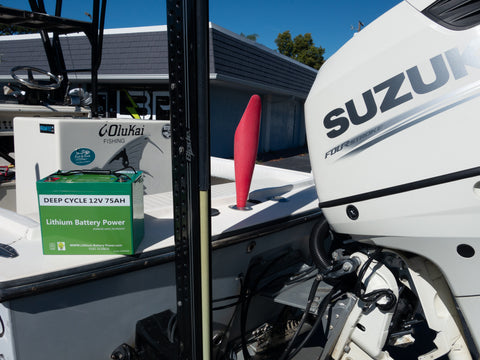A Guide to Choosing the Best Boat Battery

As more technology is added to boats, more and more power is required to keep things afloat. In this article we go over some of the most important things to consider when shopping for a boat battery.

Choosing the Right Boat Battery: A Complete Guide for First-Time Buyers
Purchasing your first marine battery can feel overwhelming. You're stepping into a world filled with unfamiliar terms like AGM, LiFePO4, CCA, and more. But don’t worry — we’ll break it all down so you can confidently power your adventures on the water.
Whether you're boating on the Florida Gulf Coast, fishing the Great Lakes, or cruising the Pacific Northwest, choosing the right battery is key to reliability and performance.
Types of Marine Batteries
Before making a purchase, it's crucial to understand the two primary types of boat batteries:
1. Cranking Batteries (Starting Batteries)
These batteries deliver the quick surge of power needed to start your engine. Cranking batteries are built with thin lead plates that allow for fast, high-current output — perfect for turning over the engine, especially in colder climates where Cold Cranking Amps (CCA) matter.
2. Deep-Cycle Batteries
These provide a steady amount of power over a long period and are essential for operating accessories such as:
-
Trolling motors
-
Fish finders
-
GPS and radios
-
Onboard lighting
Deep-cycle batteries are recharged after every outing and built to handle repeated charging cycles. They're often made with thicker plates to endure longer use.
3. Dual-Purpose Batteries
A hybrid of starting and deep-cycle batteries, these are best suited for smaller boats that can’t house two separate batteries. While convenient, dual-purpose batteries typically have shorter lifespans due to the increased workload.
Types of Battery Chemistry
Beyond function, batteries are also categorized by their internal chemistry. Here's what you’ll find on the market:
Wet-Cell (Flooded Lead-Acid)
Traditional and cost-effective, these batteries can offer up to 1,000 recharge cycles if properly maintained. However, they require routine water top-offs and are more vulnerable to vibration and spillage — not ideal for rougher waters.
AGM (Absorbed Glass Mat)
AGM batteries are sealed, maintenance-free, and highly resistant to vibration. Popular for their reliability and cleaner operation, they’re a strong step up from wet-cell batteries, though they tend to be heavier and pricier.
Gel Batteries
Gel batteries use a silica-based gel to suspend the electrolyte, offering long life and extreme temperature resistance. However, they require special chargers and can be less forgiving if not handled properly.
Lithium Batteries (LiFePO4)
Lithium batteries — especially LiFePO4 (Lithium Iron Phosphate) — are quickly becoming the standard in marine power systems. Why? Because they deliver unmatched benefits, including:
-
Significant weight savings
-
5,000+ charge cycles (compared to ~300 for typical lead-acid)
-
Fast charging with minimal heat build-up
-
Eco-friendliness and zero maintenance
-
Longer shelf life and deeper discharges
At Lithium Battery Power, our advanced LiFePO4 marine batteries outperform legacy tech like NiMH and AGM. Whether you're upgrading from an older NiMH marine battery or starting fresh, lithium is the superior choice in both performance and longevity.
Key Specs to Understand Before Buying
CCA and MCA
If you're buying a starting battery, look at the Cold Cranking Amps (CCA) and Marine Cranking Amps (MCA):
-
CCA: Power at 0°F for 30 seconds
-
MCA: Power at 32°F for 30 seconds
Always consult your boat’s engine manual — but when in doubt, higher is better.
Battery Group Sizes
Common sizes include Group 24, 27, and 31. A lower number generally means a smaller, lighter battery, but also less energy storage. Make sure your battery matches your boat's tray dimensions and power requirements.
Reserve Capacity (RC)
RC measures how long a battery can deliver 25 amps at 80°F before dropping below 10.5 volts. This spec matters if you're using electronics and lighting extensively between charges.
Cycle Life
A key advantage of lithium marine batteries is their extended cycle life. While a standard AGM might offer 300–500 cycles, Lithium Battery Power’s LiFePO4 solutions provide over 5,000 — translating to years of reliable boating.
Other Things to Keep in Mind
Manufacture Date
Always check the manufacture date. Look for the freshest battery possible — usually labeled with a letter and number code (e.g., D4 = April 2024).
Battery Chargers
Not all chargers are compatible with all battery types. Lithium batteries often require a lithium-specific charger or a smart charger with proper voltage profiles. Using the wrong charger can shorten your battery’s life — or even void the warranty.
Why Choose Lithium Over NiMH or Lead-Acid?
NiMH boat batteries were once a popular upgrade from lead-acid, but lithium tech has since eclipsed them. Here's why more boaters in the U.S. — especially in high-demand marine areas like Florida, Texas, and California — are switching:
-
Lithium is lighter, charges faster, and lasts longer
-
Delivers stable voltage until fully discharged
-
No memory effect like NiMH
-
No maintenance, no spills, and no venting required
The Easy Choice for Marine Power
Shopping for your first boat battery doesn’t need to be stressful. Whether you're cruising, fishing, or going off-grid, having the right battery makes all the difference.
Explore our LiFePO4 marine batteries, built for serious power, extended cycle life, and rugged use. Backed by over a 5,000-cycle guarantee, our lithium batteries are trusted by boaters across the U.S.
Get back on the water — faster, longer, and worry-free.
